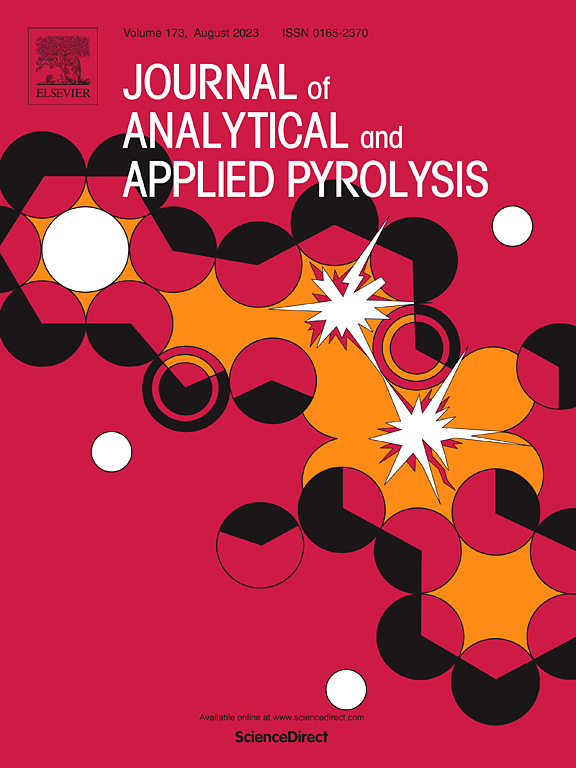Investigation of in situ and ex situ catalytic pyrolysis of lignocellulosic biomass waste for the production of de-oxygenated C8-C18 range enhanced liquid fuel precursor - reaction mechanisms and optimization
IF 6.2
2区 化学
Q1 CHEMISTRY, ANALYTICAL
引用次数: 0
Abstract
Pyrolysis oil derived from lignocellulosic biomass waste is considered a viable alternative to fossil fuels. Nonetheless, organic acids and other oxygenated components render it unsuitable for direct fuel uses. A feasible option for utilizing pyrolysis oil is to process it with refinery feedstock, leveraging existing infrastructure. The adaptability of pyrolysis oil for co-processing can be enhanced by decreasing the acidity, generating the oil within a C8-C18 carbon range, and reducing high concentrations of phenols and aromatics. Catalytic pyrolysis represents a viable method for producing high-quality biooil. Currently, the catalysts are expensive, and their recovery poses a significant concern, incurring additional costs. The study uses various metal-impregnated eggshell catalysts to examine lignocellulosic biomass waste pyrolysis under in situ and ex situ configurations. The study indicates that both catalytic methods yield pyrolysis oil within the C8-C18 carbon number range, with diminished organic acid levels and lower concentrations of aromatics and phenols. The GC-MS NMR, and GC analysis of pyrolysis products suggested that ex situ catalysis exhibited improved selectivity for C8-C18 products, increasing from 48.12 % to 98.56 %. A substantial decrease in oxygenated compounds was observed, declining from 93.1 % to 72.3 %. The acid content of pyrolysis oil decreased from 37.1 % to negligible levels. Among the various metal-impregnated catalysts tested, CaO-Cu and CaO-Fe impregnated catalysts showed a significant improvement in the quality of pyrolysis oil. The study on the reaction mechanisms indicates that the presence of the catalyst substantially modifies the pyrolysis mechanism, validating the alterations in the product distribution. The study demonstrates the preparation of an economically viable metal-impregnated catalyst that efficiently produces deoxygenated, acid-free pyrolysis oil from biomass. The catalyst recoverability and reusability in the ex situ catalytic pyrolysis process enhance the sustainability and cost effectiveness.
原位和非原位催化热解木质纤维素生物质废弃物制备脱氧C8-C18范围增强液体燃料前驱体的研究——反应机理及优化
从木质纤维素生物质废料中提取的热解油被认为是化石燃料的可行替代品。然而,有机酸和其他含氧成分使其不适合直接用作燃料。利用裂解油的一个可行选择是利用现有基础设施与炼油厂原料一起加工。通过降低酸度、生成C8-C18碳范围内的热解油、减少高浓度的酚类和芳烃,可以增强热解油对协同加工的适应性。催化热解是一种生产高质量生物油的可行方法。目前,这些催化剂价格昂贵,而且它们的回收引起了很大的关注,产生了额外的成本。本研究使用不同的金属浸渍蛋壳催化剂来研究木质纤维素生物质废弃物在原位和非原位构型下的热解。研究表明,两种催化方法均能生成碳数在c8 ~ c18范围内的热解油,且有机酸含量降低,芳烃和酚类物质浓度降低。热解产物的GC- ms NMR和GC分析表明,非原位催化对C8-C18产物的选择性从48.12 %提高到98.56 %。观察到含氧化合物的大量减少,从93.1 %下降到72.3 %。热解油的酸含量从37.1% %下降到可以忽略不计的水平。在所测试的各种金属浸渍催化剂中,CaO-Cu和CaO-Fe浸渍催化剂对热解油的质量有显著的改善。对反应机理的研究表明,催化剂的存在极大地改变了热解机理,证实了产物分布的改变。该研究展示了一种经济可行的金属浸渍催化剂的制备,该催化剂可有效地从生物质中生产脱氧无酸热解油。在非原位催化热解过程中,催化剂的可回收性和可重复使用性提高了可持续性和成本效益。
本文章由计算机程序翻译,如有差异,请以英文原文为准。
求助全文
约1分钟内获得全文
求助全文
来源期刊
CiteScore
9.10
自引率
11.70%
发文量
340
审稿时长
44 days
期刊介绍:
The Journal of Analytical and Applied Pyrolysis (JAAP) is devoted to the publication of papers dealing with innovative applications of pyrolysis processes, the characterization of products related to pyrolysis reactions, and investigations of reaction mechanism. To be considered by JAAP, a manuscript should present significant progress in these topics. The novelty must be satisfactorily argued in the cover letter. A manuscript with a cover letter to the editor not addressing the novelty is likely to be rejected without review.

 求助内容:
求助内容: 应助结果提醒方式:
应助结果提醒方式:


